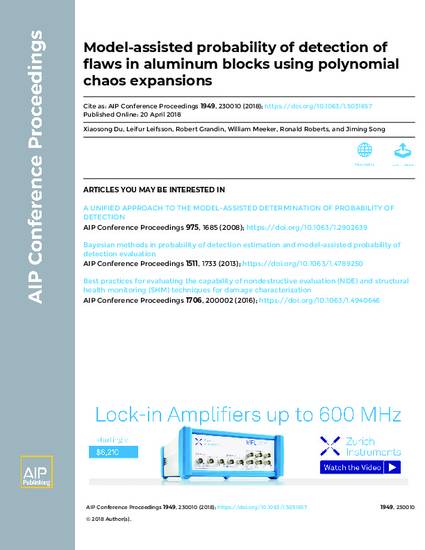
Probability of detection (POD) is widely used for measuring reliability of nondestructive testing (NDT) systems. Typically, POD is determined experimentally, while it can be enhanced by utilizing physics-based computational models in combination withmodel-assisted POD (MAPOD) methods. With the development of advanced physics-basedmethods, such as ultrasonic NDTtesting, the empirical information,needed for POD methods, can bereduced. However, performing accurate numerical simulationscan be prohibitivelytime-consuming, especially as part of stochastic analysis. In this work, stochastic surrogate models for computational physics-based measurement simulations are developed for cost savings of MAPOD methods while simultaneously ensuring sufficient accuracy. The stochastic surrogate is used to propagate the random input variables through thephysics-basedsimulation model to obtain the joint probability distribution of the output. The POD curves are then generated based on those results. Here, the stochastic surrogates are constructed using nonintrusive polynomial chaos (NIPC) expansions. In particular, the NIPC methods used are the quadrature, ordinary leastsquares (OLS), and least-angle regression sparse (LARS) techniques. The proposed approach is demonstrated on the ultrasonic testing simulation of a flat bottom hole flaw inanaluminum block. The results show that the stochastic surrogates have at least two orders of magnitude faster convergence on the statistics than direct Monte Carlo sampling (MCS). Moreover, the evaluation of the stochastic surrogate models is over three orders of magnitude faster than the underlying simulation modelfor this case,which is the UTSim2 model.
Available at: http://works.bepress.com/robert_grandin/21/

This proceeding may be downloaded for personal use only. Any other use requires prior permission of the author and AIP Publishing. This proceeding appeared in Du, Xiaosong, Leifur Leifsson, Robert Grandin, William Meeker, Ronald Roberts, and Jiming Song. "Model-assisted probability of detection of flaws in aluminum blocks using polynomial chaos expansions." AIP Conference Proceedings 1949, no. 1, (2018): 230010, and may be found at DOI: 10.1063/1.5031657. Posted with permission.